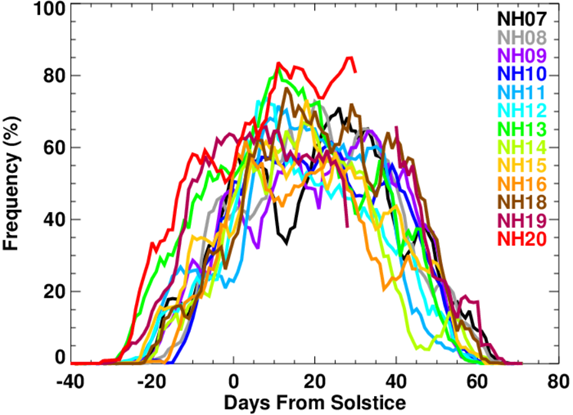|
STATUS:
07.29.2020
Instrument Status:
The spacecraft continues to perform nominally.
CIPS
The CIPS instrument is healthy and continues to function well. A new polar mesospheric cloud (PMC) retrieval, v5.20r05, was developed to handle the varying satellite operations in recent years. Data for all available PMC seasons were processed with this new retrieval algorithm and released in spring 2020. The current northern hemisphere (NH) PMC season began on 17 May 2020. This was the second earliest PMC season onset in the CIPS data record. The season continues to be a strong one, as shown in the figure. Throughout the 2020 season, daily PMC frequencies have exceeded frequencies in all or most previous years. Although not shown, this is consistent with lower-than-typical temperatures and higher-than-typical water vapor mixing ratios, as measured by the NASA Microwave Limb Sounder. These conditions are consistent with low solar activity, but definitive attribution is still under investigation.

Figure Caption: CIPS daily PMC frequencies at 80°N latitude from 2007-2020. The most recent data correspond to 21 July 2020.
SOFIE
SOFIE continues to collect nominal science observations, and housekeeping parameters all indicate a stable and healthy instrument. SOFIE V1.3 data are available online.
SOFIE nitric oxide (NO) measurements were recently validated through detailed uncertainty analysis and comparisons with independent observations [Hervig et al., 2019]. SOFIE was compared with coincident satellite measurements from the Atmospheric Chemistry Experiment (ACE) - Fourier Transform Spectrometer (FTS) instrument, and the Michelson Interferometer for Passive Atmospheric Sounding (MIPAS) instrument. The comparisons indicate mean differences of less than ~50% for altitudes from roughly 50 to 105 km for SOFIE spacecraft sunrise, and 50 to 140 km for SOFIE sunsets (see Figure). Comparisons of NO time series show a high degree of correlation between SOFIE and both ACE and MIPAS for altitudes below ~130 km, indicating that measured NO variability in time is robust. SOFIE uncertainties increase below ~80 km due to interfering H2O absorption, and from signal correction uncertainties which are larger for spacecraft sunrise compared to sunset. These errors are sufficiently large in sunrises that reliable NO measurements are infrequent below ~80 km.
Hervig, M. E., B. T. Marshall, S. M. Bailey, D. E. Siskind, J. M. Rusell III, C. Bardeen, K. A. Walker, and B. Funke (2019), Validation of SOFIE nitric oxide measurements, Atmos. Meas. Tech. Discuss., https://doi.org/10.5194/amt-2019-56. (article)

Comparison of SOFIE and MIPAS NO vertical profiles, for coincident measurements in the SH (SOFIE spacecraft sunset; local sunrise), as a) average profiles, and b) mean and RMS differences
|
